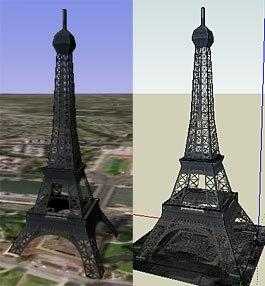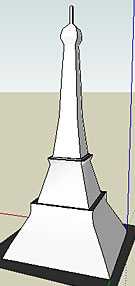The key to optimizing a SketchUp model that you are going to place in Google Earth is to keep the model complexity as light as possible. A model's complexity is directly related to its polygon count (number of faces).
Face count can increase rapidly. If you have a square, you have one face; if you pull it up into a cube, you have six faces. If you have a standard 24-sided circle, you have one face; if you pull it up into a cylinder, you have 26 faces.
Model a complex structure like the Eiffel Tower in Paris, and you can easily end up with thousands of faces. Rendering a model with heavy geometry in Google Earth can take a lot of graphics resources. And that's just one structure. Imagine the number of faces in an entire neighborhood.
Fortunately, there are a few things you can do to reduce the number of faces, but still end up with a model that presents well.
Use image textures on simplified structures
You can make a much simpler model in SketchUp, project an image of the real structure onto it, and end up with a quite realistic looking model to place in Google Earth 4. A structure like the Eiffel Tower might end up with only a couple hundred faces instead of thousands.
Here's a view of a model of the Eiffel Tower in Google Earth, and the same model in SketchUp. Notice that it is realistic looking, and that you can look through the structure, just as you can with the real tower.

The model is displayed in Google Earth and SketchUp with textures turned on ("View" › "Face Style" › "Shaded with Textures"). Here's what the same model looks like in SketchUp with the textures turned off ("View" › "Face Style" › "Shaded").

To do this:
- Take photos of the structure you want to model and convert them into images that are optimized for the Web.
Note: Use PNG or JPG. If you need to be able to look into or through the structure, choose the PNG format, which preserves transparency. (If your image does contains transparency, don't colorize the image; a colorized image with transparency won't display correctly in Google Earth.) Make sure you optimize both the image dimensions and resolution. Since this is for on -screen display, a resolution of 72 ppi is adequate, and your image dimension should be 640 x 480 or smaller. Your goal is to keep the image size as light as possible so it doesn't add unnecessary weight to the model.
- Create a simple model with the correct dimensions:
- Get a current image from Google Earth and trace the footprint.
- Pull it up to the correct height. If you can't find the structure's actual dimensions, you can usually come quite close by creating its height relative to the footprint.
- You won't need to add any geometry like windows and doors, but you should create prominent geometry like porches and porticoes, roofs and dormers, and wings.
- Import and place the image:
- Open the "File" menu.
- Click "Import."
- Select the file type.
- Browse to and select the image.
- Select "Use as Texture."
- Click "Open."
- Click at one corner of your structure to set one corner of the image, stretch it across to the opposite corner, and then click again. The image is now a texture on the face.
- If necessary, reposition the image: right-click it (Mac = Ctrl+click), point to "Texture," and then click "Position." For more information about how to position texture, see the SketchUp Help (see Contents › Modification Tools › Position Texture Tool).
- As necessary, paint textures on other parts of the structure, for example, paint a roofing material on the roof.
To see how effective this approach can be, search the 3D Warehouse for [google-sketchup-signature-buildings photo-textures].
Reduce face count by simplifying geometry
This technique is particularly effective with large buildings for which the overall feel of the building when viewed as a whole is more important than granular details. For example:
- You can dramatically reduce fact count by simplifying windows. When you are viewing a building with hundreds or thousands of windows, it is more important to show the correct position of the windows than it is to model a realistic window with sills and trim.
- You can effectively reduce face count by reducing the number of sides that curves have. For example, the tapered steel crown of the Chrysler Building is made up multiple, half-circle arcs. A default half-circle arc has 12 sides, but you can easily reduce the number of sides to five, eliminating 168 faces, while still preserving the feel of the building.
To see an example of this approach, search the 3D Warehouse for [google-sketchup-signature-buildings 405 Lexington Avenue]. |


